Planetarian or
Environmental Artwork
Part 2 -
PLANETARIAN ARTWORK
is a new form of artistic expression,
where the image tells a story about local natural ecosystems or
the planetary environment, and the title of the image explains
that story in depth, as shown below. These stories are to express
the concept of "Whole Planet Awareness" or in
the French language, "Conscience Planète Entière."
Title: "Design for a New Flag, for one of the desert countries
located between India and Morocco, to start to harvest the summer
monsoonal moisture that is passing over each season, by replanting
the local native trees like the Acacia shown in the image,
plus replant and protect the local native perennial grasses, to
cool the soil surface, lower the atmospheric dust, and encourage
the clouds to form, the rain to fall, and the streams to flow
again."
Digital image, taken from the 8" x 10" acrylic on canvas. Painting #20 in catalogue. Copyright image and text © 2012 by Craig Carlton Dremann, all right reserved.
Title: "HOW IT MIGHT LOOK IN THE FUTURE...17 new countries,
including Alaska, Hawaii, Puerto Rico, USVI, Guam, Amer. Samoa
(which includes the other dependent
Pacific islands)--and in addition to the human political changes,
the most important change will be each different country and their
relationship to the whole earth's environment like their plans
to manage CO2 production and their relationship with the local
natural world." Digital image 7" x 10". Number
21 in catalogue. Copyright image and text © 2012 by Craig
Carlton Dremann, all right reserved.
Title: "THE ONE MILLION YEAR HISTORY OF TOOLS, that makes things fly, fire tamed by humans about 125,000-1,7 million years ago, and helped us evolve into the species we are today, cooking our food allowed us to extract nutrients from our food more quickly and efficiently, and allowed us to have smaller jaw muscles, which made room for more brains, and fire made ceramics at least 32,000 years ago, and the power of the fire is used to multiply out muscle power with machines, and grow and transport food, fuel, water, and goods, and the fires in modern times have been stoked by the burning of millions of years worth of buried fossil fuels, that has caused a planetary increase in CO2 and global warming, and then fire used to power rockets, that are used as tools to explore the solar system; plus the bow as a tool that made the arrow fly with the bird-feather fletching, invented at least 64,000 years ago, and the jet plane that can allow humans to fly like the birds, also powered by fire, and its exhaust forms high-elevation contrail clouds from the daily 90,000 flights, is so widespread that it impacts the planet's climate"
Acrylics and permanent marker on canvas,
8" x 10" Painting #22 in catalogue. Copyright image
and text © 2012 by Craig Carlton Dremann, all right reserved.
Title: "THE 17,300 YEAR HISTORY OF WALL PAINTINGS, from the
Lascaux cave in France, the ancestor of cattle, a male Auroch,
is one of the 900 animal paintings on the walls of that cave,
and a modern wall painting in 2012 is also shown, from East Palo
Alto, California on an empty grocery store building wall at the
corner of Glen Way and East Bayshore, and both show one of the
traits that distinguishes ourselves as humans--the production
of wall paintings."
Acrylics on canvas, 8" x 10" Painting #23 in catalogue.
Copyright image and text © 2012 by Craig Carlton Dremann,
all right reserved.
Title: "LIVING THE HIVE LIFE, where creatures that were born
with exoskeletons or manufacture exoskeletons that they can travel
in, live in colonies that contain thousands to millions of individuals
controlled by hierarchies, who build living structures, and feed
each other, and has stores of food for the entire colony, and
communicates to cooperate, and each individual has a specialized
job to do to support the whole hive structure and functions."
Acrylics on canvas, 8" x 10" Painting
#24 in catalogue. Copyright image and text © 2012 by Craig
Carlton Dremann, all right reserved.
Title: "OUR LADY OF THE CALIFORNIA POPPIES, mourning the
massive extinction of the wildflowers that blanketed the Western
States every spring for tens of millions of years, until the cows
and sheep ate them, but she is hoping that we will become aware
of their loss, and replant them, to make her smile again. "
Acrylics and pencil on canvas, 8" x 10" Painting #25
in catalogue. Copyright image and text © 2012 by Craig Carlton
Dremann, all right reserved.
Title: "INTELLIGENT DESIGN OF THE VENUS FLY TRAP--this plant
grows in nutrient poor sand, and genetic studies estimate to have
evolved about 65 million years ago, when it devised a method to
become an animal-like predator and obtain nutrients, by trapping
and digesting insects and absorbing them through its leaves,
and since so many different aspects of its insect trapping and digesting process must work perfectly together, in order for the plant to survive as a species, it could not have evolved gradually by natural selection:
For example, the plant like all plants, have to be able to detect both light and gravity, and in addition to that, must have an awareness of its surroundings is deficient in key nutrients, and it must also be aware that insects exist and that insects contain the nutrients they need, and be able to design a trap that could successfully trap the insect,
then design a method to digest and absorb the nutrients from the insect through its leaves with a stomach-like action, instead of through its roots like other plants, and design a method to move and also design a method to sense when an insect lands, and to be able to devise a way to move, and to be able to time the speed of that movement to successfully trap the insect,
and design the traps to be the proper size for your insect prey, and design "muscles" in the trap, and those "muscles" be strong enough to hold the prey still, long enough to digest it, and to achieve the right balance between the size of the trap and its ability to hold the prey still, and be able to close the trap fast enough to trap the prey,
and to produce a clamshell-like trap whose both sides meet precisely, and to be able to 'smell' aromas in the air, and make the connection that a particular scent can attract a particular insect prey, and be able to reproduce that scent on your leaves to bait your trap to lure the insects to you,
and to be able to count, so that it takes at least two movements of the insect to trigger the trap, instead of a single twig or leaf, and you need to have a memory, even a short term one, to be able to keep track of those two movements,
and all these developments had to be made at the same time, for the whole process to work together, all within one generation of the Venus Fly Trap ancestors in the distant past--
So in order to create the Venus Fly trap, its ancestor must have had the ability to intelligently design the trap within one generation, using awareness of its surroundings, awareness of the insects, know that the insects contain the nutrients they needed, invent the correct sized traps with the correct speed and strength,
and design a method to digest and absorb the nutrients from the insect, and be able to sense the prey in order to trigger the trap, be able to move at the right speed, bait the trap with a scent you know attracts your intended prey, and able to count to two, and remember the count with at least a short term memory--
and these remarkable plants only grow in
small areas of North and South Carolina, that Charles Darwin called
in his 1875 book on insectivorous plants--One of the most wonderful
plants in the world."
Acrylics on canvas, 8" x 10" Painting #26 in catalogue.
Copyright image and text © 2012 by Craig Carlton Dremann,
all right reserved.

Title: "INTELLIGENT DESIGN of the DANDELION
seed--how did the dandelion develop a seed like that, because
it could not have evolved by random selection--the weight, balance
and design to be able to float in the wind and the seed with its
pappus compressed in the calyx then expand to float away is a
remarkable achievement.
Acrylics and colored markers on canvas, 8" x 10" Painting
#27 in catalogue. Copyright image and text © 2012 by Craig
Carlton Dremann, all right reserved.
Title: "THE THIN LINE OF EARTH'S ATMOSPHERE
that protects us from the vacuum and near absolute zero of the
universe, created by earth's gravity, the oceans, clouds and plants
all working together, and protected from the solar winds by the
magnetic field formed by the planet's molten radioactive core--and
intentionally the moon and stars are not show here, to keep us
from diverting our attention, of starting the job of keeping our
planet's systems intact, and instead spend money and efforts on
trying to create a science-fiction fantasy of living on another
planet or star."
Acrylics on canvas, 6" x 12".
Painting #28 in catalogue. Copyright
image and text © 2012 by Craig Carlton Dremann, all right
reserved.
Title: "CALIFORNIA'S SACRED TREES, THAT BRING THE RAINS EACH YEAR, from left to right, the Douglas fir, California bay laurel, redwood and California live oak, and without them, we would be living in a barren desert."
Acrylics on canvas, 8" x 10" Painting #29 in catalogue.
Copyright image and text © 2012 by Craig Carlton Dremann,
all right reserved.
Title: "ARABIA'S ANCIENT RIVERS are
about to flow again, after ecological restoration of the native
grasses, wildflowers and trees begins, and this vase is created
to hold and celebrate the return of the blooming wildflowers that
live again after a 6,000 year absence."
Ceramic flower vase, 5" x 7" #30 in catalogue. Copyright
image and text © 2012 by Craig Carlton Dremann, all right
reserved. This piece is for sale.
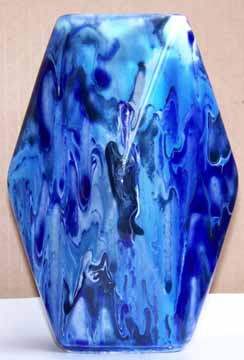
Title: "ARABIA'S ANCIENT WATERFALLS are about to flow again,
like the huge one located at 18 deg.08'24.10"N, 45
deg.25'05.88"E, after ecological restoration
of the native grasses, wildflowers and trees begins, and this
vase is created to hold and celebrate the blooming wildflowers
that live again after a 6,000 year absence."
Image from Google Earth, showing the huge dry Arabian
waterfalls.
Ceramic flower vase, 5" x 7" #31 in catalogue. Copyright
image and text © 2012 by Craig Carlton Dremann, all right
reserved. This piece is for sale.
The Sahara mustard attacking in background, catastrophically
blanketing the native plant habitat.
----------------------------------------------------
County Road S22 - April 2005 - Raw data.
Results of a 70 mph windshield survey (or
whatever the local speed
limits were), of three exotic Mustards: Either not present; is
present
along roadsides or in medians; or is outside of the roadside to
the
fence line or has moved from the roadsides to infest adjacent
land.
NS = None Seen. None of the three exotic
Mustards of concern were
seen along roadside ditches; or if divided highway, also not seen
in
the roadside median, or in lands adjacent to the road.
RS = Road Sides were infested. MED = In
divided highways, in
medians.
DES = One or more Exotic Mustards have moved
from the roadsides
into the desert, agricultural areas, or other lands adjacent to
the
roadsides. FL = Only found along the highway cyclone-fence line,
but is far enough off the roadside to pose an immediate problem
for
the lands adjacent to the fences. At the time of the survey, did
not
appear to be moving off the fence line yet.
SPECIES PRESENT:
BT = Brassica tournefortii = Sahara Mustard
SL = Sisymbrium irio = London Rocket
SO = Sisymbrium orientale = Indian Hedge Mustard
PM = Post miles along highways, and numbers
indicate the averages
found not just at each post mile, but for 1/2 mile on either side
of
the post mile marker.
(Landmarks and other notes on other exotics
or native plants will be
in parentheses)
----------------------------
SAN DIEGO COUNTY, from junction of Cal.
86, west to Cal.
highway 79
Survey 4/4/2005, may be periodically updated.
(Odometer miles noted because PM markers not seen)
0-1 - DES - BT to the horizon!
1 - DES - BT & SL scattered
2 - DES - BT in creosote, solid
3 - DES - BT rare
4 - NS - Badlands
5 - NS - Tabletop of badlands
6 - DES - BT rare
7 - DES - BT rare, with Schimus
7.4 - Riverside County line, Microwave tower
----------------------------------
SAN DIEGO COUNTY, Riverside County line,
west to junction of
Cal. 79
Raw data April 4, 2005, and may be periodically updated.
Starts at Riverside County line (PM 38.9)
38 - DES - BT rare, scattered Hilaria grassland
relics
37 - RS - BT rare, badlands
36 - NS - Tabletop of badlands
35 - DES - BT scattered
34 - DES - BT scattered
33 - DES - BT thick, solid on hills
32 - DES - BT solid
31 - DES - BT solid from roadside to dry lake in Clark Valley,
3
miles away
30 - DES - BT solid
29 - DES - BT solid
28 - RS - BT scattered
27 - DES - BT scattered
26 - RS - BT scattered
25 - DES - BT taking over sand verbena areas
24 - DES - BT & SL to the horizon
23 - DES - BT & SL to the horizon
22 - DES - BT & SL scattered - town of Borrego Springs
21 - DES - BT & SL scattered
20 - DES - BT & SL solid
19 - DES - BT scattered - end of town
18 - RS - BT rare
17 - RS - BT & SL rare - upgrade begins
16 - RS - BT & SL
15 - NS - (Encelia)
14 - RS - BT rare
13 - RS - BT scattered
12 - RS - BT thick, solid
11 - DES & RS - BT thick - (Phacelia and red brome starts
where
Encelia ends)
10 - RS - BT - (becomes rare where foxtails and red brome is thick)
9 - RS - BT & SO
8 - DES - BT thick
7 - RS - SL rare - (scrub oaks begin)
6 - NS - Ranchita, at summit
5 - NS - (carpet of yellow wildflowers)
4 - NS - (Coast Live Oaks & evidence of last year's fire)
3 - NS - (Ripgut grass and lupines start)
2 - NS - (Carpets of goldfields)
1 - RS - SL (first California poppy seen)
0 - RS - SL common
Junction of Cal. Hwy. 79
=========================
Title: The 2005, 2000+ mile-by-mile survey
for Saharan mustard invading the California and Southwest deserts,
on the web site at https://www.ecoseeds.com.mustards.html
Digital photo and web page. Copyright image and text © 2005
by Craig Carlton Dremann, all right reserved.
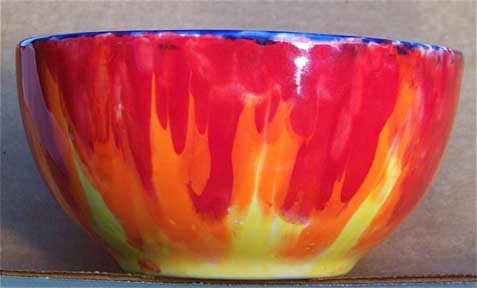
Title: Fire and water.
Ceramic 6" x 3" bowl #32 in catalogue. Copyright image and text © 2012 by Craig Carlton Dremann, all right reserved. This piece is for sale.
English edition
French edition
Creole edition
Title: "The Crystal Clear Rivers project, where all of your
agricultural practices produce crystal clear water in all of the
streams and rivers, so that you can count all the rocks at the
deepest parts at the bottoms of all the rivers, for all the people
of Haiti and all of the other island dwellers and inhabitants
of the tropical and subtropical world, where you convert rice
straw and bamboo into biochar pellets, and your no-till agriculture
uses sugar cane bagage and rice straw and banana-leaf mulch to
cover the fields instead of weeds, and you apply bean inoculant
on every single legume seed you plant--like black beans, red beans,
garbanzos, lentils, scarlet runner beans and black eye peas--and
you use powdered limestone in all the fields that need calcium
for good crop growth, and you determine that by planting pepper
plants and see if the leaves wrinkle or not, and keep adding limestone
until the wrinkles disappear."
Digital Images, 4" x 4", #33a, 33b and 33c in catalogue. Copyright image and text © 2012 by Craig Carlton Dremann, all right reserved.
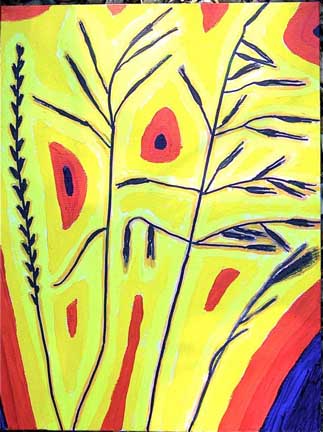
Title: "The FIVE BILLION BUNCHGRASS
SPIRITS SCREAM when the FOUR ANNUAL WEED GRASS HORSEMEN of the
California native grassland apocalypse appear, from left to right,
perennial ryegrass, ripgut grass, wild oats and foxtails, covering
99.9% of California grasslands, where native bunchgrasses and
hundreds of species of wildflowers grew for millions of years,
and these weeds have changed the geologic history of the state,
because the bunchgrass phytoliths will be missing from the rock
layers, immediately after the Europeans arrived."
Acrylics and permanent marker on canvas, 12" x 16" Painting
#34 in catalogue. Copyright image and text © 2012 by Craig
Carlton Dremann, all right reserved.
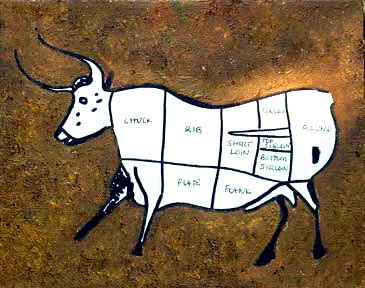
Title: "WHEN THE WILD and SACRED becomes
domesticated and a commodity--the cattle image from the Lascaux
cave in France, is now domesticated and has been bred so that
the weight of the world's cattle is equal to that of all of the
humans, and is now chopped into cuts of meat to feed the omnivore
primates with canine teeth and their pets."
Acrylics on canvas, 8" x 10" Painting #35 in catalogue.
Copyright image and text © 2012 by Craig Carlton Dremann,
all right reserved.
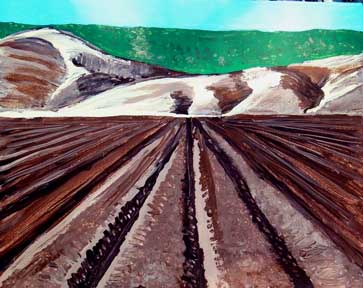
Title: "HUMAN BONDAGE OF THE BEST SOIL--the
plowed rows looking like prison bars in the native grassland soil,
whose rich soils formerly fed the multitudes of other species,
now essentially sterilized to act as a medium to produce the human's
domesticated crops, and in the background is the east side of
the California coast range, which are ancient sand dunes that
got eroded when there was more precipitation, and the perennial
native bunchgrasses that used to cover those hills, have been
replaced by the European annual weed grasses in the last 150 years--however,
the coast range mountains in the distance are still fortunately
covered with native trees, Sacramento valley along I-505."
Acrylics on canvas, 8" x 10" Painting #36 in catalogue.
Copyright image and text © 2012 by Craig Carlton Dremann,
all right reserved.
Title: "ASSIMILATION STILL LIFE and
THANK YOU NOTE to the Native American farmers who selected these
crops, that we stole from you to form the foundation of our economic
wealth and distinctive cultures worldwide for all the rest of
the humans, especially your remarkable crop selection ability,
to take a wild grass like Teosinte, which in the wild is less
than a dozen single seeds linked together like railroad cars on
a train, and be able to take that wild grass and develop it into
corn with many rows of seeds attached to a cob, including the
yummy avocado and important potato and tomato, plus the spicy
peppers, because we are the Caucasian Europeans and your distinctive
domesticated and sacred plants have been assimilated and made
part of our collective, and regarding the farmlands of North America
taken from the indigenous farmers, we wrote new titles with markings
in the English language on dried tree trunks that we ground up
and formed into 8.5" x 11" and 8.5" x 14"
sheets and deposited them in County Courthouses across the land,
and transferred title of your farms and villages to your new overlords,
or in the case of California's First Peoples, your oak orchards
were cut down for fire wood, and your native lily bulb Mima mound
fields were destroyed by our sheep and cattle and exotic grasses,
and we rounded you up into the Catholic Mission concentration
camps where you died of diseases that you had no resistance to,
and for all others, a bounty was put on your scalps by the State
and Federal governments, and on August 13, 1853, the Governor
of the State of California declared extermination of all Indians
in the State, and thank you for the beautful land we stole and
thank you for your food crops, that we enjoy each and every day."
Acrylics and pencil on canvas, 8" x 10" Painting #37 in catalogue. Copyright image and text © 2012 by Craig Carlton Dremann, all right reserved.
Title: "MURDER AT JASPER RIDGE and BUTTERFLY X, the X marks the spot where "Ishi" the last Bay Checkerspot in the area died in 1998--perhaps Stanford University forgot to manage the exotic grass weeds and thistles that were taking over the butterfly native nectar and food plants needed by the butterflies for their survival, and those important plants were pushed to the edge of the path that you can see in the picture, with a few scattered poppies still surviving in the tsunami of European grass weeds that were green in April 2012 as shown here--fortunately these few remaining flowers indicate that dormant and viable wildflower seeds may still survive in the soil underneath the exotics, so if the exotics were properly managed each year, there is a good possibility of, at the least, the wildflower's and the native bunchgrass plant's return.
Acrylics on canvas, 8" x 10" Painting
#38 in catalogue. Copyright image and text © 2012 by Craig
Carlton Dremann, all right reserved.

Title: "The MYSTERY and MAGIC of SYMBOLS
that create written history, and the fact that you are reading
this painting title is one of the most remarkable inventions of
the human species, because prior to the invention of symbols that
could record history and represent thought and concepts, all history
had to be memorized, so the invention of symbols for thought and
mathematics changed everything, and that change was told by David
Damrosch in 'The Buried Book', where the scribes invented symbols
in Ukuk, Mesopotamia, originally for merchants to keep track of
merchandise and accounts, and then the transition to true writing
occurred between 3300 and 3200 BCE, and an early poem 'Emmerkar
and the Lord of Aratta' describes Gilgamesh's grandfather as inventing
the first clay tablet, which he used to deliver an ultimatum to
the distant ruler of Aratta in Persia, who was taken aback by
the new technology, and the ruler gloomily stares at the tablet,
overwhelmed by the sheer power of writing: 'The Lord of Aratta
looked at the kiln-fired clay. The words were fierce words. Frowning,
the Lord of Aratta kept looking at his piece of clay.' ---and
today it is difficult to imagine a world without writing, but
when you convert from a direct-read medium like clay tablets or
paper, to digital methods that requires a electronic translating
interface, a lot of current history contained in electronic records,
could easily be lost, because a lot of ancient history was lost
for thousands of years even on clay or stone or papyrus, when
the ability to read Mayan glyphs and Egyptian hieroglyphs, and
cuneiform tablets was forgotten, until keys to translate were
discovered, and the Zuni pottery design is included, because the
history of writing as symbols used by the North American Indians,
have used pottery designs to tell stories, and the MYSTERY that
exists, is the independent invention of writing on two continents,
and the Arabic and Chinese and Greek inscriptions in this painting
each tell an environmental story in themselves."
Acrylics, permanent marker, white-out fluid on canvas, 8"
x 10" Painting #39 in catalogue. Copyright image and text
© 2012 by Craig Carlton Dremann, all right reserved.
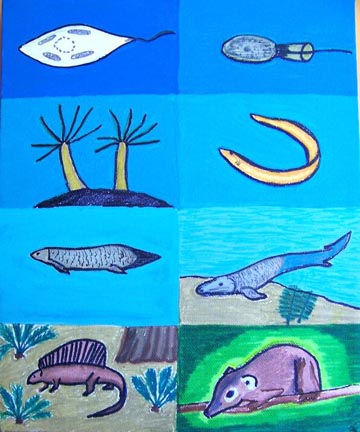
Title: "MY FAMILY ALBUM, going back 1.5 billion years, with
the single cell or Eukaryotic organism, and you can see this picture
is from when my ancestor's cell absorbed a bacterium and did not
digest it, and made it a part of the cell, called a mitochondria,
which has its own set of chromosomes and replicates independently
within the cell, and cells cannot produce by themselves, and then
900 million years ago, my Choanoflagellate ancestors developed,
and they were the organisms that eventually grouped together to
form sponges and sea anemones about 580 million years ago, then
my flat worm with gills ancestor appeared about 500 million years
ago, then my relative grandpa lung fish or lobe-finned fish appeared
with four limbs, then 375 million years ago, grandma Tiktaalik
raised her head above water, having a neck, elbows and arms, and
280 million years ago, uncle Sail-back Pelycosaur, and in this
case cousin Dimetrodon, walked on land and ate the cycads growing
in the shade of the redwoods, and then 85 million years ago, my
first primate ancestor appeared, who looked like a tree shrew."
Acrylics on canvas, 8" x 10" Painting
#40 in catalogue. Copyright image and text © 2012 by Craig
Carlton Dremann, all right reserved.
Craig Carlton Dremann's
new type of artwork captures
the underlying stories from the natural world, that the landscapes
can tell us. Developed to increase our understanding of human
and natural world interactions. The titles provide a unique vantage
point to interprete the image in an entirely different way.
The titles guide
us to become aware of the details
and histories of the dynamic world we share, and our roles and
responsibilities, and how we can make intentional positive changes
by becoming aware.
Copyright Notice for Liquidated Damages: Lifting text or images from this web page
without a license, you agree to pay on demand, $100 per sentence
per day or $100 per image per day as liquidated damages.
Updated December 20, 2022